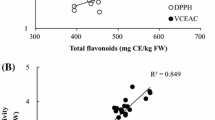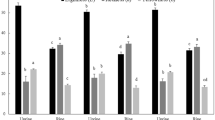Abstract
Effects of different factors on the content of phenolics, anthocyanins, antioxidants and colour parameters in two varieties of Aronia and three varieties of Saskatoon berries were evaluated. The berries were extracted by dynamic solvent extraction using three different solvents (water, 50% ethanol (v/v) and dimethyl sulfoxide) and subsequently analysed by ultraviolet visible near infrared spectroscopy and electron paramagnetic resonance followed by chemometric analysis. The results obtained show that, dimethyl sulfoxide was the most appropriate for berries functional components isolation, and among the studied berries, Aronia exhibited the highest contents of phenolics. Besides that, varieties of Aronia melanocarpa Viking and of Amelanchier lamarckii Ballerina were selected as the cultivars with high contents of functional components. Satisfactory differentiation of berries was achieved according to extraction solvent, fruit type, variety and production years. The results obtained reveal that, phytochemical composition of Aronia and Saskatoon berries may vary depending on genotypic factors, climate, growing conditions as well as on extraction method used for their assessment. Sample processing, genotypic and seasonal factors had significant effect on the concentration of naturally occurring compounds in berries.

Similar content being viewed by others
Abbreviations
- ANOVA:
-
Analysis of variance
- CDA:
-
Canonical discriminant analysis
- EPR:
-
Electron paramagnetic resonance spectrometer/spectrometry
- FRAP:
-
Ferric reducing antioxidant power
- PCA:
-
Principal component analysis
- TAA:
-
Total antioxidant activity
- TAC:
-
Total anthocyanin content
- TPC:
-
Total phenolic compounds content
- UV-VIS-NIR:
-
Ultra violet visible near infrared spectrophotometer/spectrometry
References
Šnebergrová J, Čížková H, Neradová E, Kapci B, Rajchl A, Voldřich M (2014) Variability of characteristic components of Aronia. Czech J Food Sci 32(1):25–30. https://doi.org/10.17221/540/2012-CJFS
Szopa A, Kokotkiewicz A, Kubica P, Banaszczak P, Wojtanowska-Krośniak A, Krośniak M, Marzec-Wróblewska U, Badura A, Zagrodzki P, Bucinski A, Luczkiewicz M, Ekiert H (2017) Comparative analysis of different groups of phenolic compounds in fruit and leaf extracts of Aronia sp.: A. melanocarpa, A. arbutifolia, and A. ×prunifolia and their antioxidant activities. Eur Food Res Technol 243(9):1645–1657. https://doi.org/10.1007/s00217-017-2872-8
Rop O, Řezníček V, Mlček J, Juríková T, Sochor J, Kizek R, Humpolíček P, Balík J (2012) Nutritional values of new Czech cultivars of Saskatoon berries (Amelanchier alnifolia Nutt.). Hort Sci 39(3):123–128. https://doi.org/10.17221/194/2011-HORTSCI
Paredes-López O, Cervantes-Ceja ML, Vigna-Pérez M, Hernández-Pérez T (2010) Berries: improving human health and healthy aging, and promoting quality life – a review. Plant Foods Hum Nutr 65(3):299–308. https://doi.org/10.1007/s11130-010-0177-1
Juríková T, Balla S, Sochor J, Pohanka M, Mlcek J, Baron M (2013) Flavonoid profile of Saskatoon berries (Amelanchier alnifolia Nutt.) and their health promoting effects. Molecules 18(10):12571–12586. https://doi.org/10.3390/molecules181012571
Lachowicz S, Oszmiański J, Seliga Ł, Pluta S (2017) Phytochemical composition and antioxidant capacity of seven Saskatoon berry (Amelanchier alnifolia Nutt.) genotypes grown in Poland. Molecules 22(5):1–17. https://doi.org/10.3390/molecules22050853
Borowska S, Brzóska MM (2016) Chokeberries (Aronia melanocarpa) and their products as a possible means for the prevention and treatment of noncommunicable diseases and unfavorable health effects due to exposure to xenobiotics. Compr Rev Food Sci Food Saf 15(6):982–1017. https://doi.org/10.1111/1541-4337.12221
Cebova M, Klimentova J, Janega P, Pechanova O (2017) Effect of bioactive compound of Aronia melanocarpa on cardiovascular system in experimental hypertension. Oxid Med Cell Longev 2017:1–8. https://doi.org/10.1155/2017/8156594
Banjari I, Misir A, Šavikin K, Jokić S, Molnar M, De Zoysa HKS, Waisundara VY (2017) Antidiabetic effects of Aronia melanocarpa and its other therapeutic properties. Front Nutr 4(53):1–6. https://doi.org/10.3389/fnut.2017.00053
Ahmad MS, Siddiqui MW (2015) Postharvest quality assurance of fruits practical approaches for developing countries, 1st edn. Springer, Berlin
Jurgoński A, Juśkiewicz J, Zduńczyk Z (2008) Ingestion of black chokeberry fruit extract leads to intestinal and systemic changes in a rat model of prediabetes and hyperlipidemia. Plant Foods Hum Nutr 63(4):176–182. https://doi.org/10.1007/s11130-008-0087-7
Tolic MT, Krbavčic IP, Vujevic P, Milinovic B, Jurčevic IL, Vahčic N (2017) Effects of weather conditions on phenolic content and antioxidant capacity in juice of chokeberries (Aronia melanocarpa L.). Pol J Food Nutr Sci 67(1):67–74. https://doi.org/10.1515/pjfns-2016-0009
Kårlund A, Moor U, Sandell M, Karjalainen OR (2014) The impact of harvesting, storage and processing factors on health-promoting phytochemicals in berries and fruits. Processes 2(3):596–624. https://doi.org/10.3390/pr2030596
Jurikova T, Sochor J, Rop O, Mlček J, Balla Š, Szekeres L, Žitný R, Zitka O, Adam V, Kizek R (2012) Evaluation of polyphenolic profile and nutritional value of non-traditional fruit species in the Czech Republic — a comparative study. Molecules 17(8):8968–8981. https://doi.org/10.3390/molecules17088968
Rop O, Mlcek J, Jurikova T, Valsikova M, Sochor J, Reznicek V, Kramarova D (2010) Phenolic content, antioxidant capacity, radical oxygen species scavenging and lipid peroxidation inhibiting activities of extracts of five black chokeberry (Aronia melanocarpa (Michx.) Elliot) cultivars. J Med Plant Res 4(22):2431–2437 ISSN:1996–0875
Rop O, Mlcek J, Jurikova T, Sochor J, Kizek R (2013) Antioxidant properties of Saskatoon berry (Amelanchier alnifolia Nutt.) fruits. Fruits 68(5):435–444. https://doi.org/10.1051/fruits/2013087
Butorová L, Polovka M, Pořízka J, Vítová E (2017) Multi-experimental characterization of selected medical plants growing in the Czech Republic. Chem Pap 71(9):1605–1621. https://doi.org/10.1007/s11696-017-0154-3
Gusti MM, Wrolstad RE (2001) Characterization and measurement of anthocyanins by UV-visible spectroscopy. Curr Protoc Food Anal Chem 0(1):F1.2.1–F1.2.13. https://doi.org/10.1002/0471142913.faf0102s00
Tobolková B, Polovka M, Belajová E, Koreňovská M, Suhaj M (2014) Possibilities of organic and conventional wines differentiation on the basis of multivariate analysis of their characteristics (EPR, UV–Vis, HPLC and AAS study). Eur Food Res Technol 239(3):441–451. https://doi.org/10.1007/s00217-014-2237-5
Iloki-Assanga BS, Lewis-Luján LM, Lara-Espinoza CL, Gil-Salido AA, Fernandez-Angulo D, Rubio-Pino JL, Haines DD (2015) Solvent effects on phytochemical constituent profiles and antioxidant activities, using four different extraction formulations for analysis of Bucida buceras L. and Phoradendron californicum. BMC Res Notes 8(396):1–14. https://doi.org/10.1186/s13104-015-1388-1
Magwaza LS, Opara UL, Cronje PJR, Landahl S, Ortiz JO, Terry LA (2016) Rapid methods for extracting and quantifying phenolic compounds in citrus rinds. Food Sci Nutr 4(1):4–10. https://doi.org/10.1002/fsn3.210
Sarkar CR, Das L, Bhagawati B, Goswami BC (2012) A comparative study of carotenoid extraction from algae in different solvent systems. Asian J Plant Sci Res 2(4):546–549 ISSN:2249–7412
Torres PB, Chow F, Furlan CM, Mandelli F, Mercadante A, Alves Cursino dos Santos DY (2014) Standardization of a protocol to extract and analyze chlorophyll a and carotenoids in Gracilaria tenuistipitata var. Liui. Zhang and Xia (Rhodophyta). Braz J Oceanogr 62(1):57–63. https://doi.org/10.1590/s1679-87592014068106201
de Ménorval MA, Mir LM, Fernández ML, Reigada R (2012) Effects of dimethyl sulfoxide in cholesterol-containing lipid membranes: a comparative study of experiments in silico and with cells. PLoS One 7(7):1–12. https://doi.org/10.1371/journal.pone.0041733
Mokrani A, Madani K (2016) Effect of solvent, time and temperature on the extraction of phenolic compounds and antioxidant capacity of peach (Prunus persica L.) fruit. Sep Purif Technol 162:68–76. https://doi.org/10.1016/j.seppur.2016.01.043
Do QD, Angkawijaya AE, Tran-Nguyen PL, Huynh LH, Soetaredjo FE, Ismadji S, Ju YH (2014) Effect of extraction solvent on total phenol content, total flavonoid content, and antioxidant activity of Limnophila aromatica. J Food Drug Anal 22(3):296–302. https://doi.org/10.1016/j.jfda.2013.11.001
Dhanani T, Shah S, Gajbhiye NA, Kumar S (2017) Effect of extraction methods on yield, phytochemical constituents and antioxidant activity of Withania somnifera. Arab J Chem 10(1):1193–1199. https://doi.org/10.1016/j.arabjc.2013.02.015
Boeing JS, Barizão ÉOE, Silva BC, Montanher PF, de Cinque Almeida V, Visentainer JV (2014) Evaluation of solvent effect on the extraction of phenolic compounds and antioxidant capacities from the berries: application of principal component analysis. Chem Cent J 8(48):1–9. https://doi.org/10.1186/s13065-014-0048-1
Tolić MT, Jurčević IL, Krbavčić IP, Marković K, Vahčić N (2015) Phenolic content, antioxidant capacity and quality of chokeberry (Aronia melanocarpa) products. Food Technol Biotechnol 53(2):171–179. https://doi.org/10.17113/ftb.53.02.15.3833
Jakobek L, Drenjančević M, Jukić V, Šeruga M (2012) Phenolic acids, flavonols, anthocyanins and antiradical activity of “Nero”, “Viking”, “Galicianka” and wild chokeberries. Sci Hortic 147:56–63. https://doi.org/10.1016/j.scienta.2012.09.006
Butorová L, Vítová E, Polovka M (2016) Comparison of volatiles identified in Aronia melanocarpa and Amelanchier alnifolia using solid- phase microextraction, coupled to gas chromatography- mass spectrometry. J Food Nutr Res 55(1):57–68 ISSN:1336–8672
Thi ND, Hwang ES (2014) Bioactive compound contents and antioxidant activity in aronia (Aronia melanocarpa) leaves collected at different growth stages. Prev Nutr Food Sci 19(3):204–212. https://doi.org/10.3746/pnf.2014.19.3.204
Skrovankova S, Sumczynski D, Mlcek J, Jurikova T, Sochor J (2015) Bioactive compounds and antioxidant activity in different types of berries. Int J Mol Sci 16(10):24673–24706. https://doi.org/10.3390/ijms161024673
Di Vittori L, Mazzoni L, Battino M, Mezzetti B (2018) Pre-harvest factors influencing the quality of berries. Sci Hortic 233:310–322. https://doi.org/10.1016/j.scienta.2018.01.058
Acknowledgements
This publication is the result of the projects “Quality and authenticity of fruit juices - study of relationships between the origin of feedstock, processing technology and quality of fruit juices” supported by the SRDA under the contract no. APVV-15-0023 and “Improvement of nutritional and sensorial parameters of fruity and vegetable drinks via an inert gases application “ITMS 26220220175, supported by the OP R&I funded by the ERDF. We would like to acknowledge the financial support from Grant no. 19-00742S supported by GACR and from the CAS Institutional Research Plan RVO:68081715. Botanists from Faculty of Horticulture, Mendel University of Agriculture and Forestry in Brno are acknowledged for samples provision.
Author information
Authors and Affiliations
Corresponding author
Ethics declarations
Conflict of Interest
The authors declare that they have no conflict of interest.
Additional information
Publisher’s Note
Springer Nature remains neutral with regard to jurisdictional claims in published maps and institutional affiliations.
Electronic supplementary material
ESM 1
(DOCX 32 kb)
Rights and permissions
About this article
Cite this article
Burdejova, L., Tobolkova, B. & Polovka, M. Effects of Different Factors on Concentration of Functional Components of Aronia and Saskatoon Berries. Plant Foods Hum Nutr 75, 83–88 (2020). https://doi.org/10.1007/s11130-019-00780-4
Published:
Issue Date:
DOI: https://doi.org/10.1007/s11130-019-00780-4




